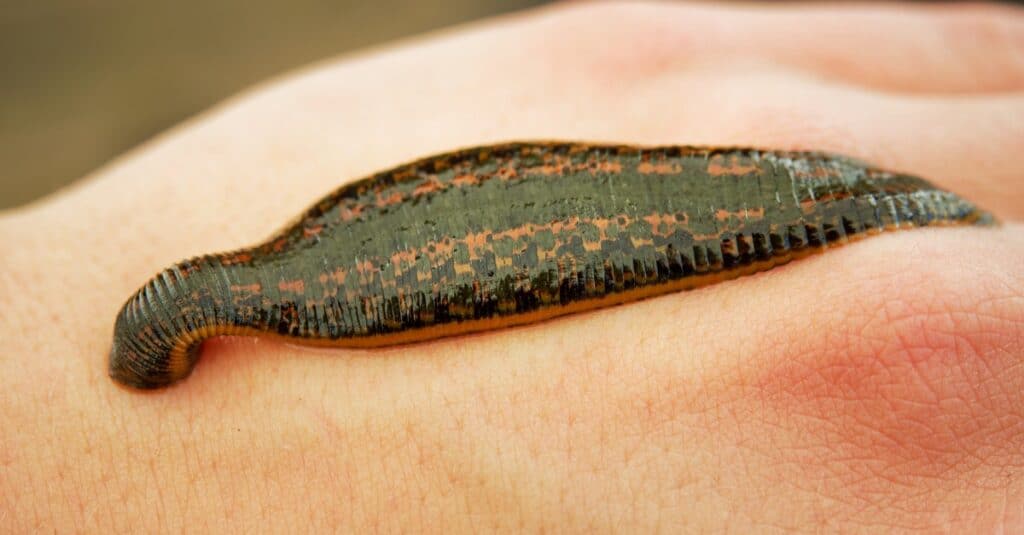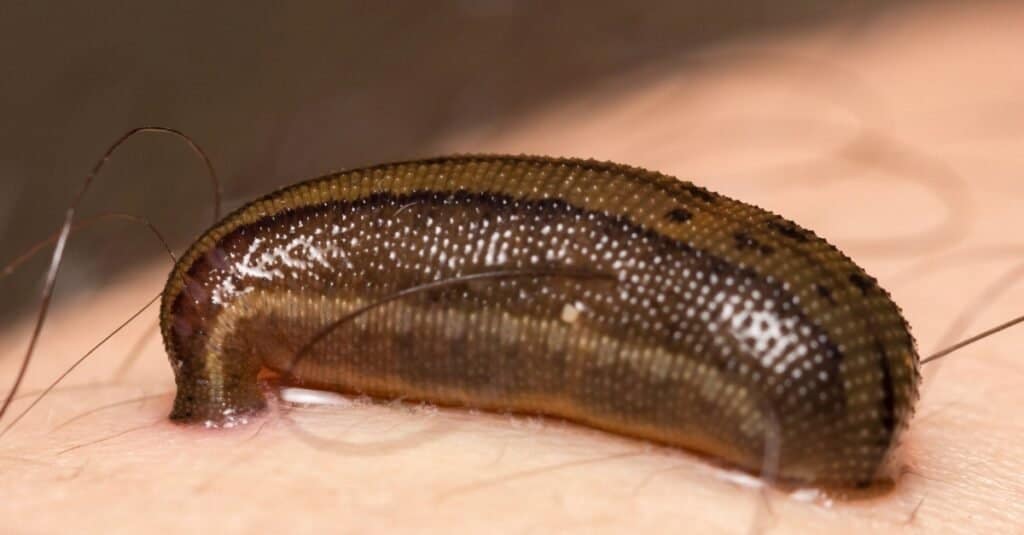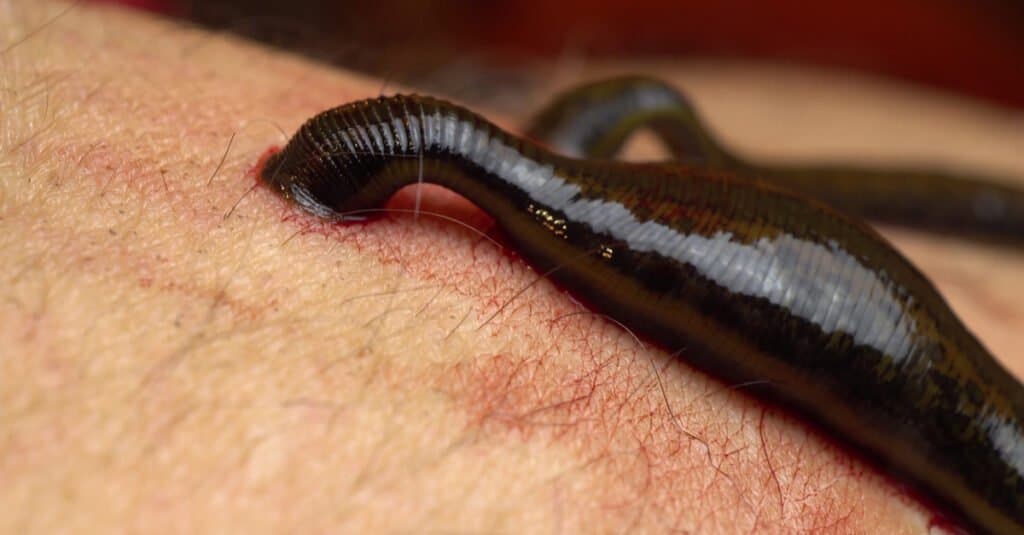There are different kinds of critters that creep around on mother Earth; some are lovely to look upon, while others are, well, scary. Leeches are one of the spooky or naughty creatures you may see in your lifetime. As small as they appear, you get chills all over your body when seen close to your skin. In essence, this small frightening species will make one feel nervous.
Although finding leeches on your body can be scary, many people are unsure if this creature can be dangerous to humans since they majorly survive on blood. Why is this so? Are leeches dangerous? In this article, we’ll find out.
Background on Leeches

Leeches are parasites that possess segmental bodies.
©Martin Pelanek/Shutterstock.com
Leeches are worm-like creatures that live in water and belong to the phylum Annelida and subclass Hirudinea. These invertebrates are parasitic creatures that get their food from human or animal hosts and possess soft, muscular, segmental bodies that may lengthen and shrink, just like the oligochaetes, including the earthworm. The body appears elastic and relatively solid, and the coelom, a large chamber in most annelids, has been reduced to microscopic channels. Most leeches dwell in freshwater; however, some populations can also be found on land or sea.
Are Leeches Dangerous?

Although leeches are not particularly dangerous to humans, their bites can result in allergic reactions.
©iStock.com/kimetan
Are leeches dangerous? Itching and purpura are common symptoms of leech bites. These tiny invertebrates are not particularly dangerous to humans. However, their bites can cause allergic reactions in some persons in rare circumstances. People who have had anaphylaxis should be especially cautious. Moreover, anticoagulant medication users are more likely to experience prolonged bleeding following a bite. Most leech bites are unintentionally fatal, and they are usually easy to remove without medical assistance. Nevertheless, the bite might result in prolonged oozing at the attachment point when the leech is removed due to the anticoagulant properties of leech saliva, which interferes with normal blood clotting.
How Many Species of Leeches are in the World?
Leeches come in over 700 different species and are most commonly found in grasses or freshwater, while some species can also be found in seawater.
How Do Leeches Feed?

Leeches feed on blood.
©Vital9s/Shutterstock.com
Many kinds of leech are sanguinivorous, meaning they suck blood. They enjoy their favorite meal once they’ve attached themselves to a human or animal and grow up to 10 times their original size while feeding, enabling them to ingest a large amount of blood at once.
How to Get Rid of Leeches?
Finding a leech is the first step to getting rid of it. These simple steps below would help you get rid of them in the shortest possible time frame.
- Find the mouth and head: The head of a leech is smaller and more slender than the rest of the body. To find the leech’s mouth, look for the narrowest region of its body, which is the area directly in contact with your skin.
- Pull the skin taut under the leech: Pull your skin taut under the leech with one hand and detach the leech from your skin by sliding a fingernail under its mouth.
- Remove the leech by flicking it away: Flick the leech away with your fingertips before it attaches.
- Ensure that the wound is clean: To keep your wound uninfected, clean it with denatured alcohol or a first-aid cleanser.
- Wrap a bandage over the wound: There will be lots of bleeding when the leech is removed. However, clean the wound up before wrapping over with a sterile bandage. For the first few hours, change the bandage periodically until the bleeding stops.
How Do leeches Find their Prey?
While leeches are typically nocturnal, they are attracted to water disturbances that cause vibrations. These water vibrations are triggered when larger animals swim by, or humans make splashes during hot summers. Leeches are pretty good swimmers, and they surprisingly emerge from their hiding place and cling to their host to feed.
Their fangs cut into the host’s skin and immediately emit an anesthetic enzyme that prevents a reflex action. The enzyme also acts as an anticoagulant, allowing blood to flow effortlessly from the host to the parasite. Before these sea invertebrates drop off and return to their lair, the leech consumes about five times its weight in a host’s blood.
How to Recognize a Leech?
Leeches, interestingly, have close relationships with worms. Fascinatingly, they are flat and differ in length depending on the species. Most of these sea creatures come in 0.3 to 3 inches in length; other species come in as long as 18 inches. The majority of leeches have visible eyeballs on the top of their bodies and circular mouths with multiple rows of teeth. They also come in varying colors and patterns, including spots, stripes, and dark colors. On each end of their body, two suckers are used to grab, eat, and move around.
Are Leeches Used for Medical Purposes?
Although leeches can be somewhat irritating, but for years, they have been employed for medicinal purposes. Their ability to suction blood out of the body was thought to be effective in sucking diseased blood out of sick patients.
The photo featured at the top of this post is © pan demin/Shutterstock.com
Thank you for reading! Have some feedback for us? Contact the AZ Animals editorial team.







